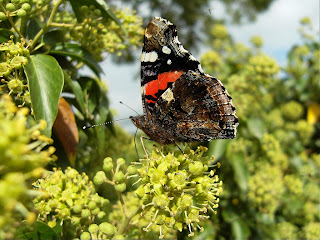Things were pretty quiet on Captains Pool due to the numbers of anglers present today but near the water's edge there was some cracking clumps of Sulphur Tuft fungi growing on the dead wood. With my old mate (and sometime cantankerous chuffer) Tony in tow it was off to the lanes.
We headed straight to Heath Lane to check the fresh plough for any new arrivals. There was a significant increase in the number of gulls present today with counts of 54 Lesser Black-backed Gulls, 38 Herring Gulls and 33 Black-headed Gulls obtained. Also noted in this area of the patch were c.100 Starlings, 3 Common Buzzards, and 2 Pied Wagtails. A single Skylark flew over heading NW. A 14-spot ladybird and a Red Admiral butterfly were also recorded.
Next stop was Witch Lane where 48 Lapwing were present on the newly seeded field. We were hoping that a Golden Plover had tagged on to the Lapwings but no such luck. A single Cormorant flew over heading SSE, 12 Skylark went through heading NE and 3 Swallow flew through heading South. A ♂ Kestrel and 2 Common Buzzard were also of note.
We decided to head back over to Heath Lane and have another look through the gulls. Well you never know there could have been a Yellow-Legged or a Common Gull amongst them. No such luck but whilst I was panning through them with the scope Tony called to me that he had just had 2 waders drop in at the top end of the field. I quickly swung my scope around to the area and sure enough there were two Golden Plover! What a result, I wouldn't have picked up on them dropping in as I was in gull scan mode but luckily TS was scanning that area with his bins at the time. As I carried on panning across I picked up a 3rd Golden Plover just right of the pair. I can only assume that it was already present in the field and the pair Tony had observed dropping in had heard it call. Either way they are a great patch bird and one that is only recorded on a handful of occasions each year.
Yet another great day. I'm starting to enjoy my local patch birding again!
Sulphur Tuft
Golden Plovers
(Archive footage taken at the same field in September 2010)

+edit+resize+-+Stone,+27th+September+2012.jpg)






+-+Devil's+Spittleful,+22nd+September+2012.jpg)





+2+-+Titterstone+Clee+Hill,+Shropshire,+15th+September+2012.jpg)





,+5th+September+2012.jpg)
+-+Trench+Wood,+6th+September+2012.jpg)


